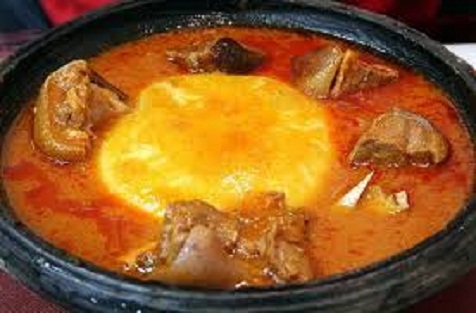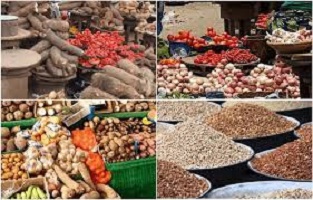Ghanaian Foods: 12 Traditional Dishes You Must Try
Ghanaian foods are typified by the distribution of food crops. Ghana encourages the use of local crops and food available in the best possible way.
Ghana is located in western Africa and lies above the equator in the northern hemisphere.
The country is situated between both the eastern and western hemispheres.
Ghana is bordered by the countries of Burkina Faso, Cote d’Ivoire, and Togo, as well as the Atlantic Ocean and the Gulf of Guinea.
Table of Contents
About Ghanaian Food
The food a group of people prepare and eat forms part of their culture.
Food is part of the African culture and Ghana is one of the African countries that have the most exquisite delicacies.
This culture reflects mostly on their local cuisine.
Ghana is one country that has held on to its culture for centuries, making it one of the most culturally rich places in the world.
Facts About Ghanaian Foods: What Types Of Food Do Ghanaians Eat?
The usual staple Traditional foods in Ghana in the southern part include cassava and plantain.
In the northern part, the key staple foods include millet and sorghum.
Yam, maize, and beans are eaten throughout Ghana as staple foods.
Sweet potatoes and cocoyam are also vital in the Ghanaian diet and cuisine.
I hope that this curated list of 12 Ghanaian local dishes will give you an insight into the various dishes in Ghana.
- Banku With Okra Soup
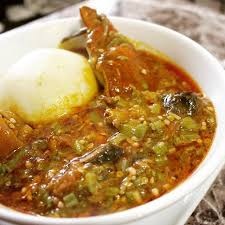
Banku is a Ghanaian dish and a favorite of the Fante, Ga, and Ewe tribe ethnic groups
The other Ghana tribes have also been spotted enjoying the meal. This means all the Ghanaians love the meal, making it a staple food.
Banku is an energy-giving food. It is prepared by a proportionate mixture of fermented corn and cassava dough using hot water.
The result is a smooth, whitish paste, served with soup, stew, or a pepper sauce with fish
- Waakye and Shito

Waakye (pronounced wa-chayy) should be made Ghana’s national dish.
This easy Ghanaian recipe is one of my preferred rice dishes from Ghana. I am yet to come across anyone who does not like waakye.
Amazingly, waakye has the simplest ingredients. It is a simple side dish of rice and beans cooked with dried millet stalk leaves.
It can be eaten with shito (Ghanaian pepper sauce/salsa) or with vegetables
- Tuo Zaafi and Ayoyo Soup
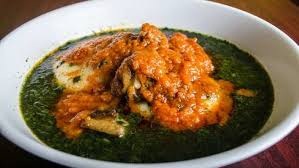
Tuo Zaafi is a popular main dish for the people of Ghana.
It is a gluten-free, steamed dumpling made from Corn and Cassava flour.
It’s enjoyed with a flavor-packed stew and Green Vegetable soup, known as Ayoyo
- Ghanaian Jollof Rice
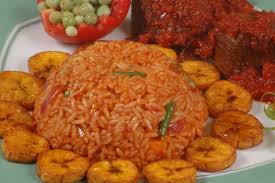
Ghanaian jollof rice is jam-packed and full of flavor. It’s spicy, full of heat, and balanced perfectly with a flavor so distinct you instantly know it’s Jollof.
This African food has stirred up plenty of interesting debate online on which African country cooks the best Jollof rice.
- Kenkey with Dried Fish
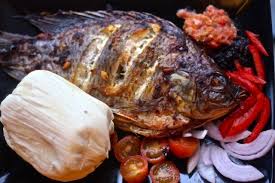
Kenkey is a typical Ghanaian dish made from fermented white corn.
It is widely consumed throughout the country by Ga people from southern Ghana.
The Ga tribe calls it komi. The Fante tribe who lives in the center of the country calls it dokono
Banku and Kenkey are two more Fufu-like staples from Western Africa, served with a soup or stew or sauce.
Banku is cooked in a pot; Kenkey is partially cooked, then wrapped in banana leaves, maize or corn husks, or foil, and steamed.
- Kokonte and Palm Nut Soup
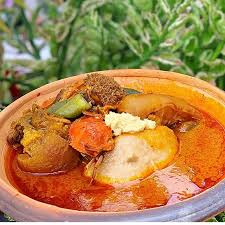
Kokonte is a popular food in Ghana and other parts of West Africa. It is usually made out of dried cassava.
It is very nutritive and it contains adequate amounts of protein and very little fat.
Kokonte with soups such as okra, palm-nut, or groundnut soups goes well together.
It is prepared similarly to fufu but is a lighter food compared to fufu.
Palm-nut soup is made from the fruit of palm trees and has a little less sweetness.
- Red Red (Beans Stew) With Plantain

Red red is a Ghanaian dish composed of black-eyed peas popularly known as beans, cooked in palm oil with plantain.
- Aboboi

Very similar to red-red, it uses plump, spherical Bambara beans, stewed up with ginger and garlic.
Aboboi is locally served with plantain fritters called tatale and a small bowl of sugar, which it is sprinkled on as a seasoning.
It sounds strange, but it works.
- Fufu Ghana Food and Goat Light Soup
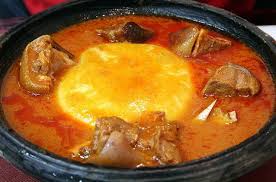
In the Eastern and Ashanti regions of Ghana, one Ghanaian food menu for home assured to work its wonder is fufu and goat light soup, the proud food of the Akan.
Fufu is a chief food across West Africa but in Ghana.
It is made by pounding a mixture of boiled cassava and plantains into a soft sticky paste to go along with spicy tomato soup.
- Omo Tuo and Groundnut Soup
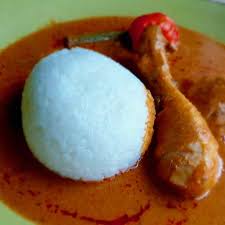
Omo Tuo (or rice balls) is another traditional Ghanaian food that shows the many ways of eating rice.
It comprises soft-boiled grains that are formed into balls and served with a variety of soups.
It makes a great accompaniment to many dishes like fufu.
Most of the time, groundnut are roasted and eaten as a snack but are used to make groundnut soup sometimes
- Chichinga

Chichinga is a popular Ghanaian street food item consisting of grilled and skewered meat that is rubbed with a spice mix known as suya.
Suya is made with ground peanuts, spices, and hot chili peppers.
The name of the dish is a transliteration of the Ghanaian word kyinkyinga, meaning kebab.
You can serve chichinga with Ghanaian salads, jollof rice, or fried plantains.
- Akotonshi
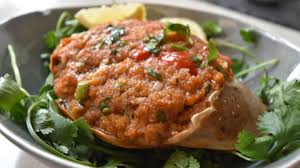
Ghana Akotonshi is a traditional stuffed crab dish. Do you know which tribe in Ghana owns this dish? Please share. I enjoy hearing from you.
People also ask Ghanaian foods
What are the traditional foods in Ghana?
Ghanaian Food: 8 Must-Try Traditional Dishes of Ghana
- Banku
- Fufu
- Yam Pottage.
- Wasawasa (Yam Flour Meal)
- Jollof Rice.
- Kelewele
- Waakye
- Tuo Zaafi.
What is the most traditional food in Ghana? Ghanaian foods
Cassava and plantain are common staple foods in Ghana’s southern region.
The main staple foods in the northern region are millet and sorghum.
Yam, maize, and beans are stapled foods in Ghana. Sweet potatoes and cocoyam are also staples in Ghanaian cuisine.
What are 5 traditional foods?
5 Traditional Foods for Outstanding Vitality
- Fermented Cod Liver Oil. Scandinavian Vikings had drums of cod livers fermenting by the doors of their homes
- Beet Kvass
- Kefir
- Sauerkraut
- Bone Broth
What are examples of traditional foods?
Traditional Foods Are :
Whole foods that are high in nutrients. Meat and poultry, eggs, whole grains, fish, beans and legumes, vegetables, fruit, nuts and seeds, dairy, and fats are examples of simple and basic foods.
How many different types of food are there in Ghana? Ghanaian foods
Ghana’s food is as diverse as its people’s, with each ethnic group having its own special dish.
From coastal towns to savannah regions, the tropical country is littered with over a thousand and one different foods.
What is Akan traditional cuisine?
Yams are the Akan economy’s staple food crop, but plantains and taro are also important; cocoa and palm oil are important commercial resources.
What is Ghana most famous for?
Ghana is celebrated not only for its lush forests, diverse animal life, and miles of sandy beaches along a picturesque coast but also for its rich history-habitation possibly dating back to 10,000 BCE-and as a fascinating repository of cultural heritage.
What is a typical Ghanaian breakfast?
Hausa Koko and Kose is a traditional Ghanaian breakfast of hot and spicy millet porridge (Hausa Koko) served with fried bean fritters (kose).
It is a breakfast of champions, a celebration of indigenous ingredients, spices, and techniques.
